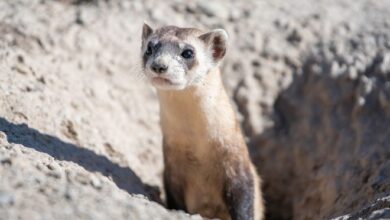‘These oracles are a vital, accessible but aging population’ – The Morning Call

Wandalyn Enix traces her family’s arrival to Bethlehem to the 1920s, when her grandparents fled the Jim Crow laws of South Carolina.
The decision positioned her father for a job at the blast furnaces of a burgeoning Bethlehem Steel plant and a home on Pawnee Street, where Enix made fond memories of getting ready for dance recitals, church and choir concerts.
But those memories also include moments of ignorance.
Like the time a white classmate asked her sister not to touch her during a dance rehearsal because “it might rub off,” referring to her skin color. Or the time the teacher was surprised because she showed up to a dance recital in a brand-new dress. Or the time a child called her brother the “N-word” while walking home from school.
Ignorance, Enix said, was present in culturally diverse south Bethlehem, but her parents — and many others in Bethlehem’s small black community — refused to allow mid-20th century stereotypes to define their futures.
“I was fortunate to be able to stand on the shoulders of those who came before me,” Enix said.
Enix achieved scholastic success alongside her nearly all white classmates. She became an accomplished vocalist at Liberty High School, graduated from Howard University, and returned to her hometown as one of the school district’s few black teachers. She received her master’s degree from Lehigh and doctorate from Temple.
Voices from the African diaspora
Her story will become part of an oral history project, “Voices from the African Diaspora: The Black Experience in Bethlehem,” spearheaded by the Bethlehem Area Public Library and partners such as Northampton Community College and Lehigh University.
The project is sponsored by the Lehigh Valley Engaged Humanities Consortium and a grant to Lafayette College by the Andrew W. Mellon Foundation.
Culling local church and civic organization records, the organizers are seeking people to tell their stories of the black experience during recent Bethlehem history.
M. Rayah Levy, head of adult services at the library, said she was inspired to pursue the project after two young students asked for information on Bethlehem’s black history, but librarians could find little.
At 7 percent, blacks make up just a sliver of Bethlehem’s white-majority population. Their numbers are eclipsed by the Hispanic community, by far the largest minority group in the city, Census figures show.
The story of the black population in Bethlehem is a powerful one, Levy said, that should be preserved “before it disappears” in a city celebrated for its strong commitment to history.
Oral histories held by an aging population
“The collective experiences of black Bethlehemites have not been recorded in any systematic way,” Levy said. “The bulk of this information exists in the memories and oral histories of those who lived it. These oracles are a vital, accessible but aging population.”
Levy is reaching out to local churches, lodges, the NAACP chapter, the James F. Goodwin Scholarship Fund and others for stories and artifacts that focus on the last 50 years. She expects to share what she learns at a public event in April.
Since Moravians settled Bethlehem in the 18th century, a small black community has always been present — first, as freed slaves. Others came during the industrial revolution that eventually produced Bethlehem Steel in the 19th century. More arrived during the “Great Migration,” a 20th-century period when millions moved north to avoid Jim Crow laws in the South, and more recent transplants.

The enclave built churches: the 1894 St. John AME Zion Church on Pawnee Street, the 1918 Second Baptist Church on Broadway and the 1925 St. Paul Baptist Church in Northampton Heights. They formed civic organizations such as the Masonic Wyoming Lodge, Colored Voters Association, Elks Lodge and NAACP chapter to provide opportunities for their community by the 1940s, according to Morning Call archives.
Enix, professor emeritus at Montclair State University, researched social history of the black community in Bethlehem. She estimates that by the 1930s, 400-500 black people lived in Bethlehem, mostly on the South Side, including a place once known as Northampton Heights near Bethlehem Steel’s Coke Works.
Racism at Steel?
Bethlehem Steel hired fewer people from the black community, a small population in the Lehigh Valley, at its hometown plant compared with other steel companies, who considered blacks cheap labor in the early 20th century when immigration restrictions reduced the amount of unskilled labor coming from Eastern Europe. Some scholars suggest there just weren’t many black people in the area to fill the jobs. Others suggest Steel wanted to avoid race riots; others attributed it to stereotyping of the day that is illegal today.
A chapter from The Morning Call’s “Forging Steel” book includes this quote about Steel’s decision not to hire as many black people during that time:
”The Mexicans are better, more dependable workers than the Negroes. The Negroes aren’t there when you want them; they go south with the cold weather,” one unidentified Bethlehem executive told sociologist Paul S. Taylor in 1929.
Enix said many local black people at the time worked in other nearby factories, or in the construction industry. Others were cooks at Lehigh University, or hired for domestic work.
She noted at least three black men ran businesses between the 1930s and 1950s. William Colloway owned a barber shop and rooming house. Frederic Bowers and Henry Warner collected refuse.
Among the Depression-era black professionals were Dr. James Nelson Richardson, a South Side dentist, and two physicians, Dr. Wilbur Strickland and Dr. James. F. Goodwin Jr., according to her research.
Born in Georgia and raised near Harrisburg in Steelton, Goodwin worked his way through college and medical school. He set up a practice in Bethlehem in 1935 but couldn’t make a living. He soon left for Reading, where he had practicing privileges at all the local hospitals, according to Enix.
Getting a leg up, then helping others
But Goodwin never forgot Bethlehem — or the plight of the young black community. Worried about its low graduation rates, Goodwin helped set up a club in the 1930s with Olivia Clark, a Bethlehem resident who graduated with a music degree from what is now called Hampton University, a historically black private college in Virginia. The club hosted activities such as homework groups, debates, dances and plays. Later a scholarship fund was set up in Goodwin’s name.
The black community in Bethlehem produced college graduates from Yale, Columbia and other elite institutions. But many did not return to Bethlehem because they could not find jobs with salaries commensurate with their education, Enix said.
Many who stayed, she said, enriched the community with their involvement in civic organizations to help provide opportunities. The organizations began in a time when some neighbors tried to prevent black families from moving into their neighborhoods.
Chartered in 1927 in Bethlehem, the Prince Hall Masons Wyoming Lodge No. 135 was formed. It established mentoring programs, helped people find a job, provided coats during the cold months or simply served as an example of what a child could aspire to.

Its members included civic-minded men who counted success not in what they took home in their paychecks, but what they gave back to the community, said Rob Tyler, the lodge’s worshipful master.
“If you are telling the minority story and the black experience and the black story in the city of Bethlehem,” Tyler said, “you can’t tell it completely or accurately without mentioning Wyoming 135.”
Its membership included people from a range of occupations. They included Clyde Gosket, a barber in Allentown and a machine operator at Bethlehem Steel; Charles Davis, a supervisor at Just Born candymaker in Bethlehem; and Alfred Hemmons, the first black attorney admitted to the Lehigh County Bar Association.
While the lodge recently moved to Allentown for space, Wyoming 135 has its roots on Brodhead Avenue, and has spent decades intertwined with other predominantly black service organizations such as Elks Lodge No. 1284.
The Elks opened in 1948 largely because its members were denied admission into other organizations and, in some cases, denied entry into bars and restaurants, according to newspaper archives.
Among the charter members of the Elks was Enix’s father, Ernest “Bubbles” Enix. Enix raised his family in Bethlehem and worked for 43 years at Steel. He was well known in the Bethlehem community: a judge of elections in the First Ward, a trustee and deacon at the Second Baptist Church and an auxiliary policeman. He was the guy, friends told reporters after his death, who instructed new neighbors where to put out their trash and drove senior citizens to the polls.
In 1997, about a year after he died at age 74, Bethlehem renamed Mohican/Pawnee Park on the South Side Enix Park.
Meanwhile, Esther Lee, who grew up on the South Side, was leaving her mark on the community. She was elected president of the school district PTA, and in 1971 became the first black person to win a seat on Bethlehem Area School Board. She left in 1977 but stayed in the public eye. She is the longtime president of the Bethlehem branch of the NAACP.
Today’s trailblazers
Winston Alozie, now 31, moved with his parents to Bethlehem 17 years ago. Like the generations before him, Alozie said his parents moved here from the South around 2001, but not for a particular job. They wanted to be closer to their extended family in New Jersey and New York. His dad opened an ice cream parlor in Allentown and operates the concession stand at the Bethlehem municipal ice rink.
Alozie recalls a childhood where he would wile away the hours at the library or Boys and Girls Club and only had one major complaint: parking.
He played with children of various backgrounds in his predominantly Hispanic neighborhood, but did not develop many connections with the city’s tiny black community while in high school. He was the only black student in some classes at Freedom High School — a stark contrast to the South, where the population was evenly divided, he said.
“We were very acutely aware that there was not a major African-American population here,” he said. “We felt very isolated because we were not from here, looking to assimilate with those whom we thought we would share cultural things with. To not see that — it’s a little off-putting.”
Alozie returned to Bethlehem as a social worker and began making those connections in, among other organizations, St. John AME Zion Church — the oldest black church in Bethlehem and believed to be the oldest black congregation in the region.
“For the longest time,” he said. “I was sitting in the pew next to trailblazers, and I didn’t even know it. A lot of folks just don’t like talking about themselves.”
And he didn’t like to pry — but bits and pieces would trickle out. He pointed to the story of Ada Brady, who died in 2012 at age 90.
He recounted a story she eventually told him about a time she was a student at Broughal Junior High. Brady wanted to be tracked to take business courses to become a secretary, but was told she should take domestics courses instead because of the color of her skin.
Brady had different plans. She earned her degree in social work from Hampton University in Virginia and her teaching certificate from Bank Street College of Education in New York.
She would later return to Bethlehem and become one of the first black teachers in the same district that advised her to become a housekeeper.
That’s a story, he said, worth preserving.
























































